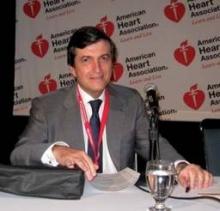LOS ANGELES – Cooling to 32° C in comatose survivors of out-of-hospital cardiac arrest secondary to a shockable rhythm yielded markedly better outcomes than did cooling to 34° C in a pilot randomized trial.
Eight of 13 patients with an initial rhythm of ventricular fibrillation or pulseless ventricular tachycardia who were cooled to 32° C (89.6° F) were alive and free of severe dependence 6 months later, compared with just 2 of 13 patients cooled to 34° C (93.2° F).
None of 10 study participants whose initial rhythm was asystole survived longer than 1 month regardless of which cooling level they received, Dr. Esteban Lopez-de-Sa reported at the annual scientific sessions of the American Heart Association.
Clinical seizures occurred during the first week post cardiac arrest in only 1 of 18 patients cooled at 32° C, compared with 11 of 18 patients cooled to 34° C. On the other hand, seven patients assigned to cooling at 32° developed bradycardia in the first week, compared with two patients cooled to 34°, noted Dr. Lopez-de-Sa, head of the cardiac critical care unit and clinical cardiology at La Paz University Hospital in Madrid.
This randomized trial helps answer an important question: how low to go with therapeutic hypothermia? Current American Heart Association guidelines recommend that comatose survivors of out-of-hospital cardiac arrest undergo therapeutic hypothermia at 32-34° C for 12-24 hours, but the guidelines don’t specify which temperature is better because data have been lacking.
Participants in the Spanish study had a median Glasgow Coma Scale score of 3 upon admission. They were maintained at their assigned target temperature for 24 hours using a feedback device before undergoing 12-24 hours of controlled rewarming.
Dr. Lopez-de-Sa observed that patients successfully resuscitated after out-of-hospital cardiac arrest often have terrible neurologic outcomes, so the 62% rate of survival without severe dependence at 6 months seen in comatose patients with a shockable initial rhythm who were cooled at 32° C in this study is quite encouraging. Freedom from severe dependence was defined as a Barthel Index score of 60 or more out of a possible 100, indicative of an ability to independently perform essential personal care.
Patients were initially cooled with intravenous cold saline. Then they had a catheter placed in the inferior vena cava through a femoral vein attached to the Thermogard XP Temperature Management System manufactured by ZOLL Medical.
Discussant Dr. Graham Nichol noted that many different methods for induction of therapeutic hypothermia exist, including cold water immersion, surface blankets, ice packs, intranasal evaporative cooling, intravenous saline, and intraperitoneal cooling. But no medical device is FDA approved for the induction of hypothermia following resuscitation from cardiac arrest.
"The optimal duration of therapeutic hypothermia, method, and the benefit in the field or in patients with a rhythm other than VF [ventricular fibrillation] remain unclear. I would offer an analogy: For hypothermia in cardiac arrest, ... we are where we were in the 1980s with thrombolytic therapy for myocardial infarction. Most clinicians believe that it works, but there are lots of unanswered questions about timing, dose, and duration," said Dr. Nichol, professor of medicine and director of the University of Washington–Harborview Center for Prehospital Emergency Care, Seattle.
Discussant Dr. Douglas P. Zipes observed that VF and pulseless VT [ventricular tachycardia] are declining as causes of cardiac arrest. Meanwhile, asystole and pulseless electrical activity represent a growing percentage of the cardiac arrest population.
"It’s very distressing that none of the patients in either group who had asystole survived," commented Dr. Zipes, professor emeritus of medicine at Indiana University, Indianapolis.
Dr. Lopez-de-Sa said he believes the therapeutic hypothermia success rate can be improved further in patients with shockable rhythms as well as in those with electromechanical dissociation.
"Probably we need to go to lower temperatures and for longer periods," according to the cardiologist.
Indeed, the superior results seen with cooling to 32° C in the Spanish study may have been due in part to the fact that patients assigned to lower cooling spent more total time in hypothermia, since it took longer to get to their target temperature, he continued.
Animal models indicate that for every 1° C drop in temperature there’s a 6% reduction in cerebral metabolic rate. So lower is probably better in terms of neuroprotection, but only to a point. And that point is 30° C, below which there is a risk of triggering arrhythmias and coagulopathies. Dr. Lopez-de-Sa said that based upon the successful pilot study, he and his coinvestigators are planning a much larger randomized trial, probably comparing 33° C to 31° C.


